Santa Claus
Santa Claus | |
|---|---|
 1881 illustration byThomas Nast | |
| Other names |
|
| Known for | Delivering gifts to children onChristmas |
| Spouse | Mrs. Claus |
Santa Claus(also known asSaint Nicholas,Saint Nick,Father Christmas,Kris Kringle,Santa,orKlaus) is alegendaryfigure[1]originating inWestern Christian culturewho is said tobring giftsduring the late evening and overnight hours onChristmas Eve.He is said to accomplish this with the aid ofChristmas elves,who make the toys in hisworkshop,and with the aid offlying reindeerwho pull hissleighthrough the air.[2][3]
The popular conception of Santa Claus originates fromfolklore traditionssurrounding the 4th-century Christian bishopSaint Nicholas,thepatron saintof children. Saint Nicholas became renowned for his reported generosity and secret gift-giving. This conception also shares similarities with the English figure ofFather Christmas,and they are both now popularly regarded as the same person.[4]
Santa is generally depicted as a portly, jolly, white-beardedman, often withspectacles,wearing a red coat with white fur collar and cuffs, white-fur-cuffed red trousers, a red hat trimmed with white fur, a black leather belt and boots, carrying a bag full of gifts for children. He is popularly associated with a deep, heartylaugh,frequently rendered inChristmas literatureas "ho, ho, ho!"
This image originated in North America during the 19th century, influenced by Dutch immigrants who brought the legend ofSinterklaas( "Saint Nicholas" ) toNew Amsterdam(present-dayNew York City), and has been maintained and reinforced through song, radio, television, children's books, familyChristmas traditions,films, and advertising.
Predecessor figures
Saint Nicholas
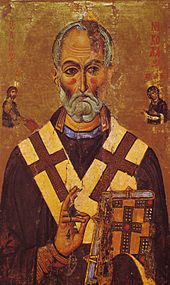
Saint Nicholas was a4th-century GreekChristian bishop ofMyra(nowDemre) in the region ofLyciain theRoman Empire,today in Turkey. Nicholas was known for his generous gifts to the poor, in particular presenting the three impoverished daughters of a pious Christian withdowriesso that they would not have to become prostitutes.[5]He was very religious from an early age and devoted his life entirely to Christianity. In continental Europe (more precisely the Netherlands, Belgium, Austria, the Czech Republic and Germany), he is usually portrayed as a bearded bishop in canonical robes.
In 1087, while theGreek Christian inhabitantsof Myra were subjugated by the newly arrived MuslimSeljuq dynasty,and soon after theirGreek Orthodoxchurch had been declared to be inschismby the Catholic church (1054 AD), a group of merchants from the Italian city ofBariremoved the major bones of Nicholas's skeleton from his sarcophagus in the Greek church in Myra. Over the objection of the monks of Myra the sailors took the bones of St. Nicholas to Bari, where they are now enshrined in theBasilica di San Nicola.Sailors from Bari collected just half of Nicholas' skeleton, leaving all the minor fragments in the church sarcophagus. These were later taken by Venetian sailors during theFirst Crusadeand placed inVenice,where a church to St. Nicholas, the patron of sailors, was built on theSan Nicolò al Lido.St. Nicholas' vandalized sarcophagus can still be seen in theSt. Nicholas Churchin Myra. This tradition was confirmed in two important scientific investigations of the relics inBariandVenice,which revealed that the relics in the two Italian cities belong to the same skeleton. Saint Nicholas was later claimed as apatron saintof many diverse groups, fromarchers,sailors, and children topawnbrokers.[5][6]He is also the patron saint of bothAmsterdamandMoscow.[7]
During the Middle Ages, often on the evening before his name day of 6 December, children were bestowed gifts in his honour. This date was earlier than the original day of gifts for the children, which moved in the course of theReformationand its opposition to the veneration of saints in many countries on 24 and 25 December. The custom of gifting to children at Christmas was propagated byMartin Lutheras an alternative to the previous very popular gift custom on St. Nicholas, to focus the interest of the children to Christ instead of the veneration of saints. Martin Luther first suggested theChristkindas the bringer of gifts. But Nicholas remained popular as gifts bearer for the people.[8][9]
Father Christmas
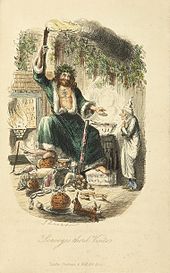
Father Christmas dates back as far as 16th century inEnglandduring the reign ofHenry VIII,when he was pictured as a large man in green or scarlet robes lined with fur.[10]He typified the spirit of good cheer atChristmas,bringing peace, joy, good food and wine and revelry.[10]As England no longer kept thefeast dayof Saint Nicholas on 6 December, the Father Christmas celebration was moved to 25 December to coincide with Christmas Day.[10]The Victorian revival of Christmas included Father Christmas as the emblem of good cheer.[11]His physical appearance was variable,[12]with one image beingJohn Leech'sillustration of the "Ghost of Christmas Present"inCharles Dickens's festive storyA Christmas Carol(1843), as a great genial man in a green coat lined with fur who takes Scrooge through the bustling streets of London on the current Christmas morning, sprinkling the essence of Christmas onto the happy populace.[10][11]
Dutch, Belgian and Swiss folklore
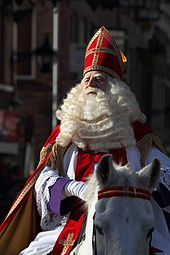

In the Netherlands and Belgium, the character of Santa Claus competes with that ofSinterklaas,based on Saint Nicolas. Santa Claus is known asde Kerstmanin Dutch ( "the Christmas man" ) andPère Noël( "Father Christmas" ) in French. For children in the Netherlands, Sinterklaas remains the predominant gift-giver in December; 36% of the Dutch only give presents on Sinterklaas evening or the day itself, 6 December,[13]while Christmas, 25 December, is used by another 21% to give presents. Some 26% of the Dutch population gives presents on both days.[14]In Belgium, presents are offered exclusively to children on 6 December, and on Christmas Day all ages may receive presents. Saint Nicolas/Sinterklaas' assistants are called "Pieten"(in Dutch) or"Père Fouettard"(in French), so they are not elves.[15]
In Switzerland,Père Fouettardaccompanies Père Noël in the French speaking region, while the sinister Schmutzli accompanies Samichlaus in theSwiss Germanregion. Schmutzli carries a twig broom to spank the naughty children.[16]
Germanic paganism, Wodan, and Christianization
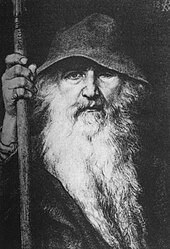
Prior to Christianization, theGermanic peoples(including the English) celebrated a midwinter event calledYule(Old Englishgeolaorgiuli).[17]With the Christianization of Germanic Europe, numerous traditions were absorbed from Yuletide celebrations into modern Christmas,[18]such as theWild Hunt,frequently attested as being led by the godOdin(Wodan), bearing (amongmany names) the namesJólnir,meaning "Yule figure", andLangbarðr,meaning "long-beard", inOld Norse.[19]
Wodan's role during the Yuletide period has been theorized as having influenced concepts of St. Nicholas and Santa Claus in a variety of facets, including his long white beard and his gray horse for nightly rides (compare Odin's horseSleipnir) or his reindeer in North American tradition.[20]Folklorist Margaret Baker maintains that "the appearance of Santa Claus or Father Christmas, whose day is the 25th of December, owes much to Odin, the old blue-hooded, cloaked, white-bearded Giftbringer of the north, who rode the midwinter sky on his eight-footed steed Sleipnir, visiting his people with gifts. Odin, transformed into Father Christmas, then Santa Claus, prospered withSt Nicholasand theChristchild,became a leading player on the Christmas stage. "[21]
In northern Europe, theYule goatwas an earlier bearer of gifts, which has to some degree become conflated with Santa Claus, for instance in the FinnishJoulupukkitradition.[22]
History
Origins
Early representations of the gift-giver from Church history and folklore, especially St Nicholas, merged with the English character Father Christmas to create the mythical character known to the rest of the English-speaking world as "Santa Claus" (a phonetic derivation of "Sinterklaas"inDutch).
In theEnglishand laterBritish colonies of North America,and later in the United States, British and Dutch versions of the gift-giver merged further. For example, inWashington Irving'sHistory of New York(1809),Sinterklaaswas Anglicized into "Santa Claus" (a name first used in the U.S. press in 1773)[23]but lost his bishop's apparel, and was at first pictured as a thick-bellied Dutch sailor with a pipe in a green winter coat. Irving's book was aparodyof the Dutch culture of New York, and much of this portrait is his joking invention.[24]Irving's interpretation of Santa Claus was part of a broader movement to tone down the increasingly wild Christmas celebrations of the era, which included aggressive home invasions under the guise ofwassailing,substantial premarital sex (leading toshotgun weddingsin areas where thePuritans,waning in power and firmly opposed to Christmas, still held some influence) and public displays of sexual deviancy; the celebrations of the era were derided by both upper-class merchants and Christian purists.[24]
19th century
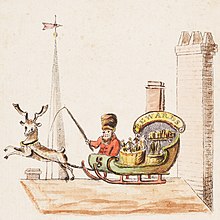

In 1821, the bookA New-year's present, to the little ones from five to twelvewas published in New York. It contained "Old Santeclaus with Much Delight",an anonymous poem describing Santeclaus on a reindeer sleigh, bringing rewards to children.[25]Some modern ideas of Santa Claus seemingly becamecanonafter the anonymous publication of the poemA Visit From St. Nicholas(better known today asThe Night Before Christmas) in theTroy, New York,Sentinelon 23 December 1823;Clement Clarke Moorelater claimed authorship, though some scholars argue thatHenry Livingston, Jr.(who died nine years before Moore's claim) was the author.[5][26]St. Nick is described as being "chubby and plump, a right jolly old elf" with "a little round belly", that "shook when he laughed like a bowlful of jelly", in spite of which the "miniature sleigh" and "tiny reindeer" still indicate that he is physically diminutive. Thereindeerwere also named: Dasher, Dancer, Prancer, Vixen, Comet, Cupid, Dunder and Blixem (Dunder and Blixem came from the old Dutch words for thunder and lightning, which were later changed to the more German sounding Donner and Blitzen).[27]
By 1845, "Kris Kringle" was a common variant of Santa in parts of the United States.[28]A magazine article from 1853, describing American Christmas customs to British readers, refers to children hanging up theirstockingson Christmas Eve for "a fabulous personage" whose name varies: in Pennsylvania he is usually called "Krishkinkle", but in New York he is "St. Nicholas" or "Santa Claus". The author[29]quotes Moore's poem in its entirety, saying that its descriptions apply to Krishkinkle too.[30]
As the years passed, Santa Claus evolved into a large, heavyset person. One of the first artists to define Santa Claus's modern image wasThomas Nast,a German-born Americancartoonistof the 19th century who immortalized Santa Claus with an illustration for the 3 January 1863 issue ofHarper's Weeklyin which Santa was dressed in anAmerican flag,and had a puppet with the name "Jeff"written on it, reflecting its Civil War context. Nast was inspired by theBelsnickel,part of the folklure in southwestern Germany, where he was born.[31]In this drawing, Santa is also in a sleigh pulled by reindeers.[citation needed]
The story that Santa Claus lives at the North Pole may also have been a Nast creation. His Christmas image in theHarper'sissue dated 29 December 1866 was a collage of engravings titledSanta Claus and His Works,which included the caption "Santa Claussville, N.P."[32]A colour collection of Nast's pictures, published in 1869, had a poem also titled "Santa Claus and His Works" byGeorge P. Webster,who wrote that Santa Claus's home was "near the North Pole, in the ice and snow".[33]The tale had become well known by the 1870s. A boy fromColoradowriting to the children's magazineThe Nurseryin late 1874 said, "If we did not live so very far from the North Pole, I should ask Santa Claus to bring me a donkey." [34]
The idea of a wife for Santa Claus may have been the creation of American authors, beginning in the mid-19th century. In 1889, the poetKatharine Lee BatespopularizedMrs. Clausin the poem "Goody Santa Claus on a Sleigh Ride". "Is There a Santa Claus?" is the title of an iconic editorial byFrancis Pharcellus Churchin the 21 September 1897 edition ofThe New York Sunthat became the most reprinted in the U.S. and included the famous reply, "Yes, Virginia, there is a Santa Claus".[35][36]
In Russia, Ded Moroz emerged as a Santa Claus figure around the late 19th century[37]where Christmas for theEastern Orthodox Churchis kept on 7 January.
20th century
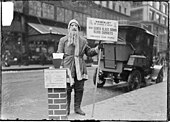
L. Frank Baum'sThe Life and Adventures of Santa Claus,achildren's book,was published in 1902. Much of Santa Claus's mythos was not firmly established at the time, leaving Baum to give his "Neclaus" (Necile's Little One) a variety of immortal support, a home in the Laughing Valley of Hohaho, andtenreindeer—who could not fly, but leapt in enormous, flight-like bounds. Claus'simmortalitywas earned, much like his title ( "Santa" ), decided by a vote of those naturally immortal. This work also established Claus's motives: a happy childhood among immortals. When Ak, Master Woodsman of the World, exposes him to the misery and poverty of children in the outside world, Santa strives to find a way to bring joy into the lives of all children, and eventually invents toys as a principal means. Santa later appears inThe Road to Ozas an honored guest at Ozma's birthday party, stated to be famous and beloved enough for everyone to bow even before he is announced as "The most Mighty and Loyal Friend of Children, His Supreme Highness – Santa Claus".

Images of Santa Claus were conveyed throughHaddon Sundblom's depiction of him forThe Coca-Cola Company's Christmas advertising in the 1930s.[5][38]The image spawnedurban legendsthat Santa Claus was invented by The Coca-Cola Company or that Santa wears red and white because they are the colours used to promote the Coca-Cola brand.[39]Coca-Cola's competitorPepsi-Colaused similar Santa Claus paintings in its advertisements in the 1940s and 1950s. Historically, Coca-Cola was not the firstsoft drinkcompany to utilize the modern image of Santa Claus in its advertising—White Rock Beverageshad used a Santa figure in monochrome advertisements formineral waterin 1915, and in 1923–25, the same company used colour images of Santa Claus in adverts for drink mixers.[40]Earlier, Santa Claus had appeared dressed in red and white and essentially in his current form on several covers ofPuckmagazine in the first few years of the 20th century.[41]
The image of Santa Claus as a benevolent character became reinforced with its association with charity and philanthropy, particularly by organizations such as theSalvation Army.Volunteers dressed as Santa Claus typically became part offundraisingdrives to aid needy families at Christmas time.
In 1937,Charles W. Howard,who played Santa Claus in department stores and parades, established the Charles W. Howard Santa School, the oldest continuously run such school in the world.[42]
In some images from the early 20th century, Santa was depicted as personally making his toys by hand in a small workshop like a craftsman. Eventually, the idea emerged that he had numerous elves responsible for making the toys, but the toys were still handmade by each individual elf working in the traditional manner.
The 1956 popular song byGeorge Melachrino,"Mrs. Santa Claus", and the 1963 children's bookHow Mrs. Santa Claus Saved Christmas,byPhyllis McGinley,helped standardize and establish the character and role ofMrs. Clausin the US.[43]
Seabury Quinn's 1948 novelRoadsdraws from historical legends to tell the story of Santa and the origins of Christmas. Other modern additions to the "story" of Santa includeRudolph the Red-Nosed Reindeer,the 9th and lead reindeer created in 1939 byRobert L. May,aMontgomery Wardcopywriter, and immortalized ina 1949 songbyGene Autry.
In popular culture
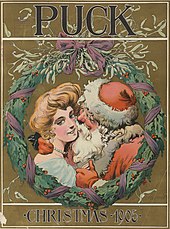

Elves had been portrayed as usingassembly linesto produce toys early in the 20th century. That shift was reflected in the modern depiction of Santa's residence—now often humorously portrayed as a fully mechanized production and distribution facility, equipped with the latest manufacturing technology, and overseen by the elves with Santa and Mrs. Claus as executives or managers.[44]
In 1912, actorLeedham Bantockbecame the first actor to be identified as having playedSanta Claus in a film.Santa Claus,which he also directed, included scenes photographed in a limited, two-tone colour process and featured the use of detailed models.[45]Since then many feature films have featured Santa Claus as a protagonist, includingMiracle on 34th Street,The Santa Clause,andElf.
In the cartoon base, Santa has been voiced by several people, includingMickey Rooney,Jim Cummings,Mel Smith,Ricky Tomlinson,Jim Belushi,andAlec Baldwin.
Santa has been described as a positive malecultural icon:
Santa is really the only cultural icon we have who's male, does not carry a gun, and is all about peace, joy, giving, and caring for other people. That's part of the magic for me, especially in a culture where we've become so commercialized and hooked into manufactured icons. Santa is much more organic, integral, connected to the past, and therefore connected to the future.
— TV producerJonathan Meathwho portrays Santa, 2011[46]
Norman Corwin's 1938 comic radio playThe Plot to Overthrow Christmas,set entirely in rhyme, details a conspiracy ofthe DevilMephistophelesand damned figures of history to defeat the good will among men of Christmas, by sending the Roman emperorNeroto the North Pole to assassinate Santa Claus. Through a battle of wits, Santa saves himself by winning Nero over to the joys of Christmas, and gives him aStradivariusviolin. The play was re-produced in 1940 and 1944.

Many television commercials,comic stripsand other media depict this as a sort of humorous business, withSanta's elvesacting as a sometimes mischievously disgruntled workforce, cracking jokes and pulling pranks on their Boss. For instance, aBloom Countystory from 15 December 1981 through 24 December 1981 has Santa rejecting the demands of PETCO (Professional Elves Toy-Making and Craft Organization) for higher wages, a hot tub in the locker room, and "Aggressive recruitment of a wider gender spectrum of employee" ( "short broads" ), with the elves then going on strike.President Reagansteps in, fires all of Santa's helpers, and replaces them with out-of-workair traffic controllers(an obvious reference to the1981 air traffic controllers' strike), resulting in a riot before Santa vindictively rehires them in humiliating new positions such as his reindeer.[47]In the 2001The Sopranosepisode, "To Save Us All from Satan's Power",Paulie Gualtierisays he "Used to think Santa and Mrs. Claus were running asweatshopover there. The original elves were ugly, traveled with Santa to throw bad kids a beatin', and gave the good ones toys. "
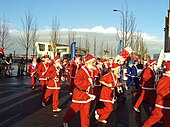
In Kyrgyzstan, a mountain peak was named after Santa Claus, after a Swedish company had suggested the location be a more efficient starting place for present-delivering journeys all over the world, than Lapland. In the Kyrgyz capital,Bishkek,a Santa Claus Festival was held on 30 December 2007, with government officials attending. 2008 was officially declared the Year of Santa Claus in the country. The events are seen as moves to boost tourism in Kyrgyzstan.[48]
TheGuinness World Recordfor the largest gathering of Santa Clauses is held byThrissur,Kerala,Indiawhere on 27 December 2014, 18,112 Santas overtook the previous record. Derry City, Northern Ireland had held the record since 9 September 2007, when a total of 12,965 people dressed up as Santa or Santa's helpers. Prior to that, the record was 3,921, which was set during the Santa Dash event in Liverpool City Centre in 2005.[49]A gathering of Santas in 2009 in Bucharest, Romania attempted to top the world record, but failed with only 3,939 Santas.[50]
Santa Claus appears in a fewvideo games.[51]
Traditions and rituals
Chimneys
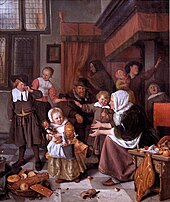
The tradition of Santa Claus being said to enter dwellings through the chimney is shared by many European seasonal gift-givers.[52]
Christmas Eve
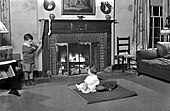
In the United States and Canada, children may leave a glass of milk and a plate ofcookiesintended for Santa; in Britain, Australia and New Zealand,sherryor beer, andmince piesare left instead. In Denmark, Norway and Sweden, it is common for children to leave him rice porridge with sugar and cinnamon instead. In Ireland it is popular to leaveGuinnessor milk, along withChristmas puddingor mince pies.
In Hungary, St. Nicolaus (Mikulás) or Father Winter (Télapó) comes on the night of 5 December and the children get their gifts the next morning. They get sweets in a bag if they were good, and a golden coloured birch switch if not. OnChristmas Eve"Little Jesus" comes and gives gifts for everyone.[53]
In Slovenia, Saint Nicholas (Miklavž) also brings small gifts for good children on the eve of 6 December. Božiček (Christmas Man) brings gifts on the eve of 25 December, and Dedek Mraz (Grandfather Frost) brings gifts in the evening of 31 December to be opened on New Years Day.
After the children have fallenasleep,parents play the role of Santa Claus and leave their gifts under theChristmas tree,which may be signed as being "from Santa Claus".[54][55][56]

Appearance
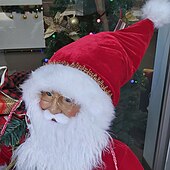

Santa is generally depicted as a portly, jolly, white-beardedman, often withspectacles,wearing a red outfit consisting of jacket, trousers and hat all lined with white fur, accessorized with black leather belt and boots, and carrying a bag full of gifts for children. The 1823 poem "A Visit from St. Nicholas"popularized this image in North America during the 19th century. Caricaturist and political cartoonistThomas Nastalso played a role in the creation of Santa's image.[57][58][59]
The traditional 1823 Christmas poemA Visit from St. Nicholasrelates that Santa has:
"a little round belly
That shook when he laugh'd, like a bowl full of jelly "
Though most often portrayed aswhite,Santa is also depicted asblackor of other races. His race or colour is sometimes a subject of controversy.[60][61]
Laugh
Ho ho hois the way that many languages write out how Santa Claus laughs. "Ho, ho, ho!Merry Christmas! "It is the textual rendition of a particular type of deep-throatedlaughor chuckle, most associated today with Santa Claus andFather Christmas.
The laughter of Santa Claus has long been an important attribute by which the character is identified, but it also does not appear in many non-English-speaking countries.[citation needed]
Home
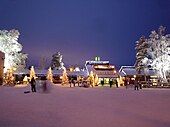

Santa Claus's home is traditionally said to include a residence and a workshop where he is said to create—often with the aid of elves or other supernatural beings—the gifts he is said to deliver to good children at Christmas. Some stories and legends include a village, inhabited by his helpers, surrounding his home and shop.
In North American tradition (in theUnited StatesandCanada), Santa is said to live at the North Pole, which according toCanada Postlies within Canadian jurisdiction inpostal codeH0H 0H0[62](a reference to "ho ho ho", Santa's notable saying, although postal codes starting with H are usually reserved for theisland of MontréalinQuébec). On 23 December 2008,Jason Kenney,Canada'sminister of Citizenship, Immigration and Multiculturalism,formally awardedCanadian citizenshipstatus to Santa Claus. "The Government of Canada wishes Santa the very best in his Christmas Eve duties and wants to let him know that, as a Canadian citizen, he has the automatic right to re-enter Canada once his trip around the world is complete," Kenney said in an official statement.[63]
There is also a city namedNorth PoleinAlaskawhere a tourist attraction known as the "Santa Claus House" has been established. TheUnited States Postal Serviceuses the city'sZIP codeof 99705 as their advertised postal code for Santa Claus. AWendy'sin North Pole, AK has also claimed to have a "sleigh fly through".[64]
EachNordic countryclaims Santa's residence to be within their territory. Norway claims he lives inDrøbak.In Denmark, he is said to live in Greenland (nearUummannaq). In Sweden, the town ofMorahas a theme park namedTomteland.The national postal terminal inTomtebodain Stockholm receives children's letters for Santa. In Finland,Korvatunturihas long been known as Santa's home, and two theme parks,Santa Claus VillageandSanta Parkare located nearRovaniemi.InBelarus,there is a home ofDed MorozinBelovezhskaya Pushcha National Park.[65]
InFrance,Santa is believed to reside in 1 Chemin des Nuages, Pôle Nord (1 Alley of Clouds, North Pole). The French national postal service has operated a service that allows children to send letters to Père Noël since 1962.[66]In the period before Christmas, any physical letter in the country that is addressed to Santa Claus is sent to a specific location, where responses for the children's letters are written and sent back to the children.[67]
Parades, department stores, and shopping malls
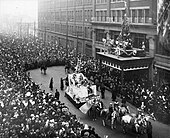
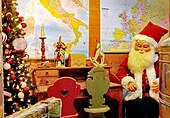
Actors portraying Santa Claus are present at various venues in the weeks leading up to Christmas. The practice of this has been credited[dubious–discuss]toJames Edgar,as he started doing this in 1890 in hisBrockton, Massachusettsdepartment store.[68]Having a Santa actor set up to take pictures with children is a ritual that dates back at least to 1918.[69]An area is often set aside for the actors portraying Santa to use for the duration of the holiday season. It usually features a chair for the actors to sit in surrounded by various holiday-themed decorations. In Canada, malls operated byOxford Propertiesestablished a process by whichautisticchildren could "visit Santa Claus" at the mall without having to contend with crowds.[70]The malls open early to allow entry only to families with autistic children, who have a private visit with the actor portraying Santa Claus. In 2012, theSouthcentre Mallin Calgary was the first mall to offer this service.[71]
In theUnited Kingdom,discount storePoundlandchanges the voice of itsself-service checkoutsto that of Santa Claus throughout the Christmas retail period.[72]
There are schools offering instruction on how to act as Santa Claus. For example, children's television producerJonathan Meathstudied at the International School of Santa Claus and earned the degreeMaster of Santa Clausin 2006. It blossomed into a second career for him, and after appearing in parades and malls,[73]he appeared on the cover of the American monthlyBoston Magazineas Santa.[74]There are associations with members who portray Santa; for example, Mr. Meath was a board member of the international organization calledFraternal Order of Real Bearded Santas.[75]
Due to theCOVID-19 pandemic,many Santa grottos were not operating for the 2020 Christmas season. Due to this, some companies offeredvideo callsfor a fee using apps such asZoomwhere children could speak to an actor who was dressed as Santa Claus.[76]
In 2021,Walt Disney WorldandDisneylandfeatured for the first time Black cast members portraying Santa.[77]
Letter writing
Children sometimes write letters to Santa Claus, often with a wish list of presents that they wish to receive.[78][79]Some postal services recognize this tradition, and may accept letters addressed to "Santa Claus".[80]Writing letters to Santa Claus has the educational benefits of promoting literacy, computer literacy, and e-mail literacy. A letter to Santa is often a child's first experience of correspondence. Written and sent with the help of a parent or teacher, children learn about thestructure of a letter, salutations, and the use of an address and postcode.[81]
According to theUniversal Postal Union(UPU)'s 2007 study and survey of national postal operations, theUnited States Postal Service(USPS) has the oldest Santa letter answering effort by a national postal system. The USPS Santa letter answering effort started in 1912 out of the historicJames Farley Post Office[82]in New York, and since 1940 has been called "Operation Santa" to ensure that letters to Santa are adopted by charitable organizations, major corporations, local businesses and individuals in order to fulfill the wishes of children.[80]Those seeking aNorth Poleholiday postmark through the USPS, are told to send their letter from Santa or a holiday greeting card by 10 December to: North Pole Holiday Postmark, Postmaster, 4141 Postmark Dr, Anchorage, AK 99530–9998.[83]
In 2006, according to the UPU's 2007 study and survey of national postal operations,France's Postal Servicereceived the most letters for Santa Claus or "Père Noël"with 1,220,000 letters received from 126 countries.[84]France's Postal Servicein 2007 specially recruited someone to answer the enormous volume of mail that was coming from Russia for Santa Claus.[80]
Other Santa letter processing information, according to the UPU's 2007 study and survey of national postal operations, include:[80]
- Countries whose national postal operators answer letters to Santa and other end-of-year holiday figures, and the number of letters received in 2006: Germany (500,000), Australia (117,000), Austria (6,000), Bulgaria (500), Canada (1,060,000), Spain (232,000), United States (no figure, as statistics are not kept centrally), Finland (750,000), France (1,220,000), Ireland (100,000), New Zealand (110,000), Portugal (255,000), Poland (3,000), Slovakia (85,000), Sweden (150,000), Switzerland (17,863), Ukraine (5,019), United Kingdom (750,000).
- In 2006,Finland's national postal operationreceived letters from 150 countries (representing 90% of the letters received), France's Postal Service from 126 countries, Germany from 80 countries, and Slovakia from 20 countries.
- In 2007,Canada Postreplied to letters in 26 languages andDeutsche Postin 16 languages.
- Some national postal operators make it possible to send in e-mail messages which are answered by physical mail. All the same, Santa still receives far more letters than e-mail through the national postal operators, proving that children still write letters. National postal operators offering the ability to use an on-lineweb form(with or without a return e-mail address) to Santa and obtain a reply include Canada Post[85](on-line web request form in English and French),France's Postal Service(on-line web request form in French),[86][87]andNew Zealand Post[88](on-line web request form in English).[89]In France, by 6 December 2010, a team of 60 postal elves had sent out reply cards in response to 80,000 e-mail on-line request forms and more than 500,000 physical letters.[81]
From 2002 to 2014, Canada Post replied to approximately "one million letters or more a year, and in total answered more than 24.7 million letters";[90]as of 2015, it responds to more than 1.5 million letters per year, "in over 30 languages, including Braille answering them all in the language they are written".[91]The tradition also exists in Great Britain[92]and Finland.[81]
In Latin America, letters are sometimes tied to balloons instead of being sent through the mail.[93]
An example of a public and private cooperative venture is the opportunity forexpatriateand local children and parents to receive postmarked mail and greeting cards from Santa during December in the Finnish Embassy inBeijing,People's Republic of China,[94]Santa Claus Village inRovaniemi,Finland, and the People's Republic of China Postal System's Beijing International Post Office.[95][96][97]
Tracking

A number of websites have been created by various organizations that have claimed to track Santa Claus' yearly journey. Some, such asNORAD Tracks Santa,theGoogle Santa Tracker,the emailSanta Tracker[98]and the Santa Update Project, have endured. Others, such as theAirservices AustraliaTracks Santa Project,[99][100][101]theDallas/Fort Worth International Airport's Tracks Santa Project,[102][103][104]theNASATracks Santa Project,[105]and theBing Maps PlatformTracks Santa Project,[106][107]have not.

NORAD Tracks Santa originated in 1955 when aSears-Roebuckad incorrectly printed the number for their Santa hotline and theContinental Air Defense Commandreceived the calls intended for the Sears hotline. The program was transferred to NORAD when it was jointly founded by the United States and Canada in 1958.[108][109]
In December 2000, theWeather Channelbuilt upon these local efforts to provide a national Christmas Eve "Santa tracking" effort, called "SantaWatch", in cooperation withNASA,theInternational Space Station,andSilicon Valley-based newmultimediafirm Dreamtime Holdings.[110]Currently, most local television stations in the United States and Canada rely upon outside established "Santa tracking" efforts, such as NORAD Tracks Santa.[111]
In addition to providing holiday-themed entertainment, "Santa tracking" websites raise interest inspace technologyandexploration,[112]serve to educate children in geography[113]and encourage them to take an interest in science.[114]
Many websites exist that claim to track Santa and his workshop. One particular website calledemailSantawas created when a 1997Canada Poststrikeprevented Alan Kerr's young niece and nephews from sending their letters to Santa; in a few weeks, over 1,000 emails to Santa were received, and the site had received 1,000 emails a day one year later.[115][116]Some websites, such as Santa's page on Microsoft's formerWindows Live Spacesor emailSanta, have used or still use "bots"or other automated programs to compose and send personalized and realistic replies.[117][118]Microsoft's website has given occasional profane results.[119][120]
Criticism
Opposition from some Christian denominations
Santa Claus has partial Christian roots inSaint Nicholas,particularly in thehigh churchdenominations that practice thevenerationof him and othersaints.VariousChristian denominationshave differing opinions Santa Claus, ranging from acceptance to denouncement.[121][122]Some Christians, particularlyCalvinistssuch as thePuritans,disliked the idea of Santa Claus as well as Christmas in general, believing that the lavish celebrations were not in accordance with their faith.[123]OthernonconformistChristians condemn thematerialistfocus of contemporary gift-giving and see Santa Claus as the symbol of that culture.[124]
Condemnation of Christmas was prevalent among 17th-century English Puritans and Dutch Calvinists. TheAmerican coloniesestablished by these groups reflected this view. Tolerance for Christmas increased after theRestoration,although Puritan attitudes toward the holiday remained unfavorable.[125]In the DutchNew Netherlandcolony, season celebrations focused on New Year's Day.
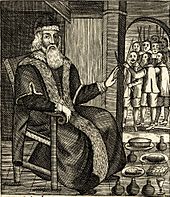
Following the Restoration of the monarchy and with Puritans out of power in England,[126]the ban on Christmas was satirized in works such as Josiah King'sThe Examination and Tryal of OldFather Christmas;Together with his Clearing by the Jury(1686).[127]
In 1958, Reverend Paul Nedergaard, a clergyman inCopenhagen, Denmark,declared Santa a "heathen goblin" (Danish:en hedensk trold) after Santa's image was used on the annual Christmas stamp (ulemærke) for a Danish children's welfare organization.[128]
Mary Baker Eddy,the founder of theChristian Sciencemovement, wrote: "the children should not be taught that Santa Claus has aught to do with this [Christmas] pastime. A deceit or falsehood is never wise. Too much cannot be done towards guarding and guiding well the germinating and inclining thought of childhood. To mould aright the first impressions of innocence, aids in perpetuating purity and in unfolding the immortal model, man in His image and likeness."[129]
Opposition under state atheism
Under theMarxist–Leninistdoctrine ofstate atheismin the Soviet Union after its foundation in 1917, Christmas celebrations—along with other religious holidays—were prohibited as a result of the Sovietantireligious campaign.[130][131]TheLeague of Militant Atheistsencouraged schoolchildren to campaign against Christmas traditions, among them being Santa Claus and theChristmas tree,as well as other Christian holidays includingEaster;the League established an antireligious holiday to be the 31st of each month as a replacement.[132][133]
In December 2018, the city management office ofLangfanginHebei province,China, released a statement stating that people caught selling Christmas trees, wreaths, stockings or Santa Claus figures in the city would be punished.[134]
Symbol of commercialism
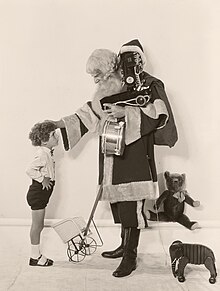
Jeremy Seal, author of the 2005 bookNicholas: The Epic Journey from Saint to Santa Claus,said in an interview that Santa's 19th-century elements, like reindeer, a sleigh, and bells, were reminiscent of the real world.[135][relevant?]
Writing inMotheringmagazine, writer Carol Jean-Swanson makes similar points, noting that the original figure of St. Nicholas gave only to those who were needy and that today Santa Claus seems to be more aboutconspicuous consumption:"He [...] mirrors some of our highest ideals: childhood purity and innocence, selfless giving, unfaltering love, justice, and mercy. [...] The problem is that, in the process, he has become burdened with some of society's greatest challenges: materialism, corporate greed, and domination by the media."[136]
In the Czech Republic, a group of advertising professionals started a website against Santa Claus, a relatively recent phenomenon in that country.[137]In the Czech tradition, presents are delivered byJežíšek,which translates asBaby Jesus.[137]
In the United Kingdom,Father Christmaswas historically depicted wearing a green cloak.[citation needed]As Father Christmas has been increasingly merged into the image of Santa Claus, that has been changed to the more commonly known red suit.[138]Santa had been portrayed in a red suit in the 19th century byThomas Nastamong others.[139][relevant?]
A law in the U.S. state ofOhioprohibits the usage of Santa Claus or his image to sell alcoholic beverages.[140]
Representation to children
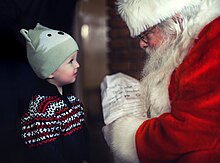
Psychologists generally differentiate between telling fictional stories that feature Santa Claus and actively deceiving a child into believing that Santa Claus is real.Imaginative play,in which children know that Santa Claus is only a character in a story, but pretend that he is real, just like they pretend that superheroes or otherfictional charactersare real, is valuable. Actively deceiving a child into believing in Santa Claus's real-world existence, sometimes even to the extent of fabricating false evidence to convince them despite their growing natural doubts, does not result in imaginative play and can promotecredulityin the face of strong evidence against Santa Claus's existence.[142][143]Children will eventually know that their parents deceived them.[144]
Babies and toddlers do not understand the concept of a fictional character, but most children become developmentally able to "believe in" Santa Claus around age three or four.[145][141]The prevalence of belief in Santa Claus is high at age five, and declines precipitously when children are seven or eight years old.[146][147][148][149]Although the age at disillusionment has been fairly stable for decades – in 1978, 85% of American five year olds believed that Santa was real, but only 25% of eight year olds still did – it may be getting slightly lower over time.[150]
Psychology professor Jacqueline Woolley helped conduct a study that found that children seemed competent in their use of logic, evidence, and comparative reasoning even though they might conclude that Santa Claus or other fanciful creatures were real. According to Woolley, the existence of Santa Claus is affirmed to children by "friends, books, TV and movies" and by "hard evidence" of "half-eaten cookies and empty milk glasses".[151]
Typical objections to presenting Santa Claus as a literally real person, rather than a story, include:
- thatlyingisnormally bad,[143]
- that parents intentionally lying to their children promotes distrust,[143]
- that it promotesselfishness,greed,andmaterialism,[152]
- that it associates good behavior with being materially rewarded with presents from Santa Claus,[152]and
- that tricking children into believing falsehoods interferes with the development ofcritical thinking.[153][142]
Some have argued that Santa Claus prioritizes parents' short-term happiness in seeing children excited about Santa Claus, and their nostalgic willingness to prolong the age ofmagical thinking,over children.[143]PhilosopherDavid Kyle Johnsonwrote, "It's a lie, it degrades your parental trustworthiness, it encourages credulity, it does not encourage imagination, and it's equivalent to bribing your kids for good behavior."[154]
Others see little harm in the belief in Santa Claus. Psychologist Tamar Murachver said that because it is a cultural, not parental, lie, it does not usually undermine parental trust.[155]Psychology professor Jacqueline Woolley posited that it is perhaps "kinship with the adult world" that causes children not to be angry that they were lied to for so long. In one study, it was found that children did not trust their parents less and adults did not recall an increase in lack of trust.[156]Austin Cline argued the problem is not with length, but with a complicated series of very large lies.[153][failed verification]Most children do not remain angry or embarrassed about the deception for very long.[156][157]They are most likely to have a positive feeling about it if they are able to figure it out logically (e.g., by realizing the impossibility of one person visiting every home in a single night) and gradually.[156][157]According to psychologist John Condry, "The most common response to finding out the truth was that they felt older and more mature. They now knew something that the younger kids did not".[157]In other studies, a small fraction of children felt betrayed by their parents, but disappointment was a more common response.[143]Some children have reacted strongly, including rejecting the family'sreligious beliefson the grounds that if the parents lied about the existence of Santa Claus, then they might lie about theexistence of Godas well.[143]TheNew Zealand Skepticsalso see no harm in parents telling their children that Santa is real. SpokespersonVicki Hydesaid, "It would be a hard-hearted parent indeed who frowned upon the innocent joys of our children's cultural heritage. We save our bah humbugs for the things that exploit the vulnerable."[155]
See also
Related figures
- Amu Nowruz— "Uncle New Year"; Iranian gift-bringing figure associated with spring and the new year in the traditional Iranian calendar
- Ayaz Ata— Grandfather Frost in Turkic folklore
- Badalisc
- Befana— a friendly witch who delivers gifts to children on 5 January
- Companions of Saint Nicholas
- Joulupukki— Finnish Santa Claus
- Moș Gerilă— name of a character from Romanian communist propaganda
- Olentzero— traditional Basque character who has recently been transformed into a Santa-like figure
- Saint Basil—who is believed to bring Christmas gifts for children inGreek Orthodoxtradition
- The Three Kings— The Biblical three wise men brings gifts on 6 January in Spain
Other
- Jack FrostandOld Man Winter— Mythical characters associated with winter
- Christmas controversy
- Flying Santa—anortheastern UStradition of pilots delivering presents to families in remote lighthouses
- Fraternal Order of Real Bearded Santas
- Pancho Claus,aTex-Mexversion of Santa Claus
- Santa Claus, Indiana—a smallMidwestern United Statestown named after the figure, home toHoliday Worldamusement park
- SantaCon
References
Citations
- ^"Santa Claus: History, Legend, & Facts".Encyclopedia Britannica.Archivedfrom the original on 25 December 2021.Retrieved10 August2020.
- ^B. K. Swartz, Jr.;The Origin of American Christmas Myth and CustomsArchived30 April 2011 at theWayback Machine;Retrieved 22 December 2007
- ^Jeff Westover;The Legendary Role of Reindeer in ChristmasArchived3 August 2012 at theWayback Machine;Retrieved 22 December 2007
- ^"Father Christmas, green or red?".BBC. 4 December 2009.
- ^abcd"Santa Claus: The real man behind the myth".NBC News.22 December 2009.Archivedfrom the original on 1 September 2020.Retrieved27 December2009.
- ^"Saint Nicholas::: People".Stnicholascenter.org.Archivedfrom the original on 27 December 2010.Retrieved21 December2010.
- ^"Saint Nicholas::: Places".Stnicholascenter.org.Archivedfrom the original on 14 December 2009.Retrieved21 December2010.
- ^Öller, Rudolf (2004)."Martin Luthers Christkind".Welt der Naturwissenschaften. Archived fromthe originalon 15 February 2008.Retrieved24 April2023.
- ^"Ein Verkaufsfahrer diente als Vorbild – angeblich – manager magazin".Archived fromthe originalon 30 December 2012.
- ^abcdWilliam J. Federer (2002). "There Really Is a Santa Claus: The History of St. Nicholas & Christmas Holiday Traditions" p. 39. Amerisearch, Inc., 2002
- ^abJacqueline Simpson, Steve Roud (2000) "English Folklore". Oxford University Press, 2000
- ^A children's party given in England on 26 December 1842 featured 'venerable effigies' of Father Christmas and the Old Year; '... Father Christmas with scarlet coat and cocked hat, stuck all over with presents for the guests... ' R. L. Brett, ed., Barclay Fox's Journal, Bell and Hyman, London, 1979
- ^Davis, Derek H. (18 November 2010).The Oxford Handbook of Church and State in the United States.Oxford University Press. pp. 334–.ISBN9780190208783.Archivedfrom the original on 1 September 2023.Retrieved20 December2017.
- ^"Nibud Pers, persberichten"(in Dutch). NIBUD. 2003. Archived fromthe originalon 14 December 2009.Netherlands budget institute table showing money spent by households categorised into those that give gifts only on Sint (36%), only on Christmas day (21%), on both days (26%)
- ^"Sinterklaas Arrival—Amsterdam, the Netherlands".St. Nicholas Center. 2008.Archivedfrom the original on 17 January 2011.Retrieved9 September2014.
- ^swissinfo.ch, Morven McLean (5 December 2008)."Schmutzli: the Swiss Santa's sinister sidekick".SWI swissinfo.ch.Archivedfrom the original on 20 May 2021.Retrieved25 December2017.
- ^Orchard, Andy (1997).Dictionary of Norse Mythology and Legend,page 187. Cassell.
- ^Simek, Rudolf(2007) translated by Angela Hall.Dictionary of Northern Mythology,pages 379–380.D.S. Brewer.& Orchard (1997:1987).
- ^For the wild hunt, Simek (2010:372–373). ForJólnir,see Simek (2010:180) and Orchard (1997:189). ForLangbarðr,see Simek (2010:186).
- ^For example, seeMcKnight, George Harley (1917).St. Nicholas; his legend and his rôle in the Christmas celebration and other popular customs.New York and London, G.P. Putman's sons.pages 24–26, 138–139;Fruehling Springwood, Charles (2009). "If Santa Wuz Black: The Domestication of a White Myth". In Denzin, Norman (ed.).Studies in Symbolic Interaction.Emerald Group Publishing. pp. 243–244.ISBN9781848557840.
- ^Baker, Margaret (2007 1962).Discovering Christmas Customs and Folklore: A Guide to Seasonal Rites Throughout the World,page 62. Osprey Publishing.
- ^Sirén, Ilkka."Does Santa Claus come from Finland?".bbc.Archivedfrom the original on 19 April 2021.Retrieved11 December2018.
- ^"Last Monday, the anniversary of St. Nicholas, otherwise called Santa Claus, was celebrated at Protestant Hall, at Mr. Waldron's; where a great number of sons of the ancient saintthe Sons of Saint Nicholascelebrated the day with great joy and festivity. "Rivington's Gazette(New York City), 23 December 1773.
- ^abFox, Justin (13 December 2019)."Christmas Was Invented in New York: The strange but probably true tale of how Washington Irving and a few contemporaries created the modern holiday in the early 1800s".Bloomberg.Archivedfrom the original on 20 May 2021.Retrieved24 December2019.
- ^"mentioning Don Foster,Author Unknown: On the Trail of Anonymous(New York: Henry Holt, 2000: 221–75) for the attribution ofOld Santeclausto Clement Clarke Moore ".Tspace.library.utoronto.ca. Archived fromthe originalon 18 July 2011.Retrieved21 December2010.
- ^Kirkpatrick, David D. (26 October 2000)."Whose Jolly Old Elf Is That, Anyway?; Literary Sleuth Casts Doubt on the Authorship of an Iconic Christmas Poem".The New York Times.ISSN0362-4331.Archivedfrom the original on 20 May 2021.Retrieved8 January2017.
- ^"What Are the True Names of Santa's Reindeer?".snopes.6 June 2001.Archivedfrom the original on 24 April 2023.Retrieved24 April2023.
- ^"Advertisement for Harrison's Bookstore".Baltimore American Republican And Daily Clipper.No. 3. 1 January 1846.
- ^The article is signed "Uneda", an anagrammatic pen-name used by William Duane (1808–1882) of Philadelphia, son ofWilliam John Duane.
- ^"Notes and Queries", volume 8 (217), 24 December 1853, p.615
- ^Aktuell, S. W. R. (3 December 2023)."Wie ein Pfälzer Auswanderer den Weihnachtsmann erfand".swr.online(in German).
- ^Thomas Nast,Santa Claus and His WorksArchived15 December 2010 at theWayback Machine,1866. The phrase "Santa Claussville, N.P." is on the curved border to the right of center, above the large word "Claus".
- ^Jeremy Seal,Nicholas: The Epic Journey From Saint to Santa Claus,Bloomsbury, 2005, p. 199–200.ISBN978-1-58234-419-5.
- ^Armstrong, Ralph (1875). Seaverns, Fanny P. (ed.)."A letter from Colorado".The Nursery.Vol. 18. John L. Shorey. p. 43.
- ^Dunlap, David W. (25 December 2015)."1933 - P.S., Virginia, There's a New York Times, Too".The New York Times.Archivedfrom the original on 24 December 2021.Retrieved25 August2022.
- ^Bever, Lindsey (22 December 2018)."'Is there a Santa Claus?': How a child's letter inspired the classic 'Yes, Virginia' response ".The Washington Post.Archivedfrom the original on 17 March 2022.Retrieved25 August2022.
- ^Nosowitz, Dan (19 December 2019)."How Santa Survived the Soviet Era".Atlas Obscura.Archivedfrom the original on 21 November 2021.Retrieved1 January2023.
- ^"Image Gallery Santa 1931".Press Center.Coca-Cola Company. Archived fromthe originalon 15 November 2012.Retrieved28 October2011.
- ^Mikkelson, David (18 December 2008)."Did Coca-Cola Invent the Modern Image of Santa Claus?".Snopes.Archivedfrom the original on 25 December 2021.Retrieved1 January2023.
- ^McKay, George. "Consumption, Coca-colonisation, Cultural resistance–and Santa Claus". In Whiteley, Sheila (ed.).Christmas, Ideology and Popular Culture.Edinburgh: Edinburgh University Press. pp. 57–59.
- ^thumb|Santa Claus on the 1902 cover of Puck magazine,thumb|Santa Claus on the 1904 cover of Puck magazine,thumb|Santa Claus on the 1905 cover of Puck magazine.
- ^Susman, Tina (30 October 2011)."Claus and effect: The ultimate Santa school".Los Angeles Times.Archivedfrom the original on 24 December 2017.Retrieved20 February2020.
- ^How did Santa Claus become popular in American culture?Archived4 December 2021 at theWayback Machine,Kiwi Report, by Jaime Levis, 2 January 2019
- ^Nissenbaum, chap. 2; Belk, 87–100
- ^"Santa Claus (1912)".BFI.org.uk.British Film Institute.Archived fromthe originalon 8 April 2023.Retrieved24 April2023.
- ^Aldrich, Ian (November 2011)."The Big Question: Why Should We Believe in Santa? We ask Kris Kringle, a.k.a. Jonathan Meath: Why Should We Believe in Santa?".Yankee Magazine.Archivedfrom the original on 9 February 2013.Retrieved12 December2012.
Santa is really the only cultural icon we have who's male, does not carry a gun, and is all about peace
- ^"High Five! Top Five! – Bizarre Santa Claus Cameos in Comics by Robert Bazz, December 13, 2010".High Five! Comics. Archived fromthe originalon 21 December 2010.Retrieved25 February2011.
- ^Pannier, Bruce (30 December 2007)."Kyrgyzstan: Central Asian Country Welcomes Santa Claus To His New Home".Radio Free Europe/Radio Liberty.Archivedfrom the original on 7 June 2023.Retrieved24 April2023.
- ^"Largest gathering of Santa Claus".Guinness World Records.27 December 2014.Archivedfrom the original on 2 October 2021.Retrieved18 October2020.
- ^"Guiness [sic] World Record Santa Claus Costumes | WebPhotoBlog | imagini, fotografii, pictures, poze, images ".Webphoto.ro. 30 November 2009.Archivedfrom the original on 14 October 2010.Retrieved29 September2010.
- ^"10 times Santa appeared in video games".Screenwanderer. 25 December 2019.Archivedfrom the original on 21 December 2021.Retrieved21 December2021.
- ^Walsh, Joseph J..Were They Wise Men Or Kings?: The Book of Christmas Questions.Westminster John Knox Press, 2001.ISBN0-664-22312-5.
- ^Kürti, László (2020).""DO YOU WANT TO BE KRAMPUS?" Santa Claus, globality and locality of Christmas tradition ".Hungarian Studies Yearbook.2(1).Sciendo:128, 134.doi:10.2478/hsy-2020-0010.ISSN2668-7542.S2CID231955746.
- ^"A Parents' Guide To Christmas: Try Not To Cry".HuffPost.20 December 2013.Archivedfrom the original on 5 October 2021.Retrieved15 July2020.
- ^Lehr, Sarah."Meet the parents who don't keep Santa's secret".Lansing State Journal.Archivedfrom the original on 28 December 2021.Retrieved15 July2020.
- ^Shabazz, Sa’iyda (17 April 2020)."The Heavy Price of Holiday Magic".The New York Times.ISSN0362-4331.Archivedfrom the original on 22 December 2021.Retrieved15 July2020.
- ^"Santa's arrival lights up the Green".Archived fromthe originalon 5 December 2012.Retrieved2 December2009.
- ^Restad, Penne L. (5 December 1996).Christmas in America: A History.Oxford University Press.ISBN9780195355093.Archivedfrom the original on 1 September 2023.Retrieved2 November2020.
- ^Auchmutey, Jim (10 December 2007)."Coke denies claims it bottled familiar Santa image".The Rocky Mountain News. Archived fromthe originalon 12 December 2007.Retrieved1 January2023.
- ^Contreras, Russell."Santa's Ethnicity Varies in Diverse U.S."NBC 5 Dallas-Fort Worth.Archivedfrom the original on 11 December 2022.Retrieved11 December2022.
- ^"What color is Santa Claus in Appalachia?".AP NEWS.23 December 2017.Archivedfrom the original on 11 December 2022.Retrieved11 December2022.
- ^"Canada Post – Newsroom – Letters to the Editor".24 April 2008. Archived fromthe originalon 24 April 2008.
- ^"Santa Claus declared a Canadian citizen".Toronto Sun.23 December 2008. Archived fromthe originalon 30 December 2010.Retrieved24 April2023.
- ^"2010–2011 North Pole Visitor Guide"(PDF).North Pole Community Chamber of Commerce. 31 March 2010.Retrieved29 September2010.[dead link]
- ^"Беловежская пуща – Фотоэнциклопедия Беларуси"(in Russian).Archivedfrom the original on 13 May 2021.Retrieved12 December2015.
- ^"Quelle est la véritable adresse du Père Noël?".MOMES.net(in French). 25 July 2014.Archivedfrom the original on 26 December 2021.Retrieved26 December2021.
- ^Choffat, Axelle."Lettre au Père Noël 2021: date, adresse... Les infos clés".linternaute(in French).Archivedfrom the original on 26 December 2021.Retrieved26 December2021.
- ^Allegrini, Elaine (15 November 2008)."James Edgar's Santa Claus—the spirit of Christmas".The Enterprise.Brockton, Massachusetts.Archived fromthe originalon 27 December 2013.Retrieved29 November2009.
- ^"A Visit from St. Nick".Squareamerica. Archived fromthe originalon 24 December 2010.Retrieved21 December2010.
- ^DeMara, Bruce (25 November 2013)."Autistic kids get quiet time with Santa at malls".Toronto Star.Archivedfrom the original on 24 December 2013.Retrieved21 December2013.
- ^"Canadian malls offer quieter, calmer visits with Santa for kids with autism".CTVNews. 24 November 2013.Archivedfrom the original on 20 May 2021.Retrieved21 December2013.
- ^Elsom, Jack (1 November 2018)."WATCH: Elvis, Dracula and Santa entertain customers at Poundland store in Derry".Derry Now.Archived fromthe originalon 30 August 2019.Retrieved30 August2019.
- ^Edward B. Colby (3 December 2009)."Town in the spirit: Dedham Square to be filled with song, shopping".Dedham Transcript.Archived fromthe originalon 21 July 2011.Retrieved13 November2010.
DEDHAM—The fifth annual Dedham Square Holiday Stroll this... At 6 p.m., Jonathan Meath – better known as Santa JG, who performs with the Boston Pops – will entertain children and families at Cafe Video Paradiso with a sing-along with Santa. "We booked him months ago because we knew that he's in demand this time of year," Haelsen says.
- ^Mary Ann Georgantopoulos (23 December 2007)."Miracle on Mass. Ave.: City Santa takes suit seriously".The Boston Globe.Archivedfrom the original on 5 March 2016.Retrieved13 November2010.
Santa Claus is coming to town. More accurately, he's from town—Cambridge that is. Jonathan Meath is the perfect fit for a Santa.
- ^Santa Glen, secretary (October 2010)."Minutes of meeting".San Diego Chapter of F.O.R.B.S. Archived fromthe originalon 22 October 2010.Retrieved13 November2010.
Hello fellow Santas, Once again we had an informative and fun gathering. Ten Santas were in attendance and we were happy to welcome Karilyn Curran, the chair person of our up and coming Santa Luncheon for 2011.... Fashion Show:... Jonathan Meath...
- ^"Santa to visit virtually as Christmas grottos cancelled".BBC News.5 November 2020.Archivedfrom the original on 6 August 2021.Retrieved17 November2020.
- ^Chang, Rachel."There Are Now Black Santas at Walt Disney World and Disneyland for the First Time in History".Travel + Leisure.Meredith.Archivedfrom the original on 21 December 2021.Retrieved1 December2021.
- ^Halkoaho, Jenniina; Laaksonnen, Pirjo (2009)."Understanding What Christmas Gifts Mean to Children"(PDF).Young Consumers.10(3): 251.doi:10.1108/17473610910986053.Archived fromthe original(PDF)on 27 September 2011.Retrieved12 December2010.
- ^Otnes, Cele; Kim, Kyungseung; Kim, Young Chan (1994). "Yes, Virginia, there is a gender difference: Analyzing children's requests to Santa Claus".Journal of Popular Culture.28(1): 23.doi:10.1111/j.0022-3840.1994.2801_17.x.
- ^abcd"Santa Claus receives more than six million letters annually and growing, 20 Dec 2007".Asian Tribune.Archived fromthe originalon 8 May 2011.Retrieved12 December2010.
- ^abc"No small job for postal elves, 15 Dec 2010".Universal Postal Union – UPU. Archived fromthe originalon 22 December 2010.Retrieved17 December2010.
- ^"Operation Santa Claus at James Farley Post Office 2012 | Operation Santa Claus – Santa's Blog".15 November 2011. Archived fromthe originalon 28 November 2011.Retrieved10 December2011.
- ^"Santa Mail – Letters to Santa".Archivedfrom the original on 12 November 2020.Retrieved25 November2014.
- ^"France answers the most Santa letters, 21 Dec 2007".xmas.co.uk. 21 December 2007. Archived fromthe originalon 17 March 2012.Retrieved12 December2010.
- ^"Canada Post – Holiday – Santa's Corner".Canadapost.ca.Archivedfrom the original on 25 December 2010.Retrieved21 December2010.
- ^"LA POSTE | Père Noël"(in French). Laposte.fr. Archived fromthe originalon 20 July 2011.Retrieved21 December2010.
- ^"Father Christmas's French office open, 18 Nov 2010".The Connexion.Archivedfrom the original on 13 December 2010.Retrieved12 December2010.
- ^"Send a letter to Santa | New Zealand Post".Nzpost.co.nz. Archived fromthe originalon 21 January 2012.Retrieved21 December2010.
- ^"NZ Post to tighten net for Santa, by Alexis Grant, 30 Nov 2004".The New Zealand Herald.30 November 2004.Archivedfrom the original on 10 August 2011.Retrieved12 December2010.
- ^"Time to write to Santa!".Canada Post.19 November 2015. Archived fromthe originalon 9 April 2016.Retrieved2 August2016.
- ^"Write to Santa and he'll write you back!".Canada Post. 5 November 2015.Archivedfrom the original on 17 August 2016.Retrieved2 August2016.
- ^"Christmas letters to Santa".Royal Mail.Archivedfrom the original on 19 June 2018.Retrieved27 December2013.
- ^'Letters to Santa Claus'. (2000). InThe World Encyclopedia of Christmas.Gerry Bowler, Editor. Toronto: McClelland & Stewart Limited. pp. 131–132.
- ^"About this site – Embassy of Finland, Beijing – Consulates General of Finland, Shanghai and Guangzhou: Current Affairs".Finland.cn. 16 May 2007. Archived fromthe originalon 11 July 2007.Retrieved21 December2010.
- ^"Beijing Post Office".Beijing Your Way. Archived fromthe originalon 7 July 2011.Retrieved21 December2010.
- ^"Beijing International Post Office".Vip.fesco.cn. Archived fromthe originalon 7 January 2008.Retrieved21 December2010.
- ^"Say hello to Santa Claus, November 24, 2010 by Zhao Hongyi".Beijing Today.Archived fromthe originalon 1 December 2011.Retrieved12 December2010.
- ^Ribeiro, Ricky."EmailSanta: How Santa Claus Went Digital".BizTech Magazine.Archivedfrom the original on 12 November 2021.Retrieved19 July2020.
- ^"Santa 2010 website by Airservices Australia".Mirror.airservicesaustralia. Archived fromthe originalon 20 December 2010.Retrieved21 December2010.
- ^"Safe Travels Santa! We will Be Watching, 19 Dec 2005".NASA's Canberra Deep Space Communications Complex. Archived fromthe originalon 16 February 2011.Retrieved4 December2010.
- ^"New technology to map Santa's flight, 24 Dec 2009".The Observer.Archivedfrom the original on 6 July 2011.Retrieved5 December2010.
- ^"DFW airport unveils Santa Tracker website, 18 Dec 2006".PegNews wire. Archived fromthe originalon 26 August 2011.Retrieved4 December2010.
- ^"DFW Airport's 'Santa Tracker' Is Operational, by BJ Austin, 24 Dec 2009".PBS KERA. Archived fromthe originalon 5 August 2011.Retrieved4 December2010.
- ^"From NORAD Santa Tracker To Twitter: Santa Tracking For Christmas Eve 2009, by Danny Sullivan, 23 Dec 2009".Search Engine Land. 24 December 2009.Archivedfrom the original on 21 May 2011.Retrieved5 December2010.
- ^"Here Comes Santa Claus! Watch it on the Web!, 24 Dec 2005".WRAL – Raleigh, Durham, Fayetteville – North Carolina's TV Station website. Archived fromthe originalon 8 August 2011.Retrieved4 December2010.
- ^"Welcome to The North Pole – A Virtual Earth 3D Experience!".Today.msnbc.msn. Archived fromthe originalon 11 August 2011.Retrieved21 December2010.
- ^"Tracking Santa with Bing Maps, by Chris Pendleton, 24 Dec 2009".Microsoft. Archived fromthe originalon 1 January 2010.Retrieved5 December2010.
- ^Gurnon, Emily (23 December 2014)."How A Sears Typo Led To NORAD's Santa Tracker".Forbes.Archivedfrom the original on 20 May 2021.Retrieved24 December2014.
- ^"Norad Santa Tracker: Christmas tradition began with a wrong number".CBC News.CBC. 24 December 2014. Archived fromthe originalon 25 December 2014.Retrieved24 December2014.
- ^"SantaWatch: Hunt for Santa to Include Clues from the International Space Station, by Dreamtime, 18 Dec 2000".Dreamtime. 18 December 2000.Archivedfrom the original on 27 December 2021.Retrieved11 December2010.
- ^"Keep track of Santa thanks to NORAD, by WKTV News, 24 Dec 2009".Dreamtime. Archived fromthe originalon 27 September 2011.Retrieved11 December2010.
- ^"NORAD Tracks Santa – Citation – Space Certification Program as a Corporate Patron Level Partner in the Certified Imagination Product Category, December 2007".Space Foundation. Archived fromthe originalon 25 September 2010.Retrieved31 December2009.
- ^"Hi-tech helps track Santa Claus, December 24, 2008".BBC News.24 December 2008.Archivedfrom the original on 16 September 2021.Retrieved31 December2009.
- ^"You'd Better Not Pout! Booz Allen Supports NORAD to Track Santa's Approach This Year, December 1, 2010 by Booz Allen Hamilton".Booz Allen Hamilton. Archived fromthe originalon 10 December 2010.Retrieved1 December2010.
- ^Rueb, Emily S. (21 December 2019)."Trying to Reach the North Pole? Check Your Wi-Fi".The New York Times.ISSN0362-4331.Archivedfrom the original on 3 November 2021.Retrieved14 June2020.
- ^"Calgary Santa receives wishes and cries for help in emails from around the world".Calgary Herald.Archivedfrom the original on 4 November 2021.Retrieved14 June2020.
- ^Ribeiro, Ricky (19 December 2012)."EmailSanta: How Santa Claus Went Digital".BizTech Magazine.Archivedfrom the original on 12 November 2021.Retrieved19 July2020.
It now offers kids and parents personalized messages from Santa, which run from an ASP script that Kerr built himself.
- ^Vnuk, Helen (7 December 2017)."Email Santa and get a reply: the website making my kids believe".MamaMia.au/.Archivedfrom the original on 2 November 2021.Retrieved19 July2020.
The one thing that's convinced my daughter, more than anything else, that Santa is real is a website, emailSanta.
- ^"Microsoft pulls plug on potty-mouth Santa, by John Fontana, 4 Dec 2007".Network World. Archived fromthe originalon 13 October 2012.Retrieved9 December2010.
- ^"For a Jolly Good Time, Chat With Santa on Windows Live Messenger, 13 Dec 2006".Microsoft. Archived fromthe originalon 24 October 2007.Retrieved9 December2010.
- ^Santa Claus: The great imposterArchived19 November 2010 at theWayback Machine,Terry Watkins, Dial-the-Truth Ministries.
- ^Cochran, Sylvia."To Santa or Not to Santa".familiesonlinemagazine.Archived fromthe originalon 5 June 2008.
- ^Kippenberg, Hans G.; Kuiper, Yme B.; Sanders, Andy F. (1 January 1990).Concepts of Person in Religion and Thought.Walter de Gruyter. p. 363.ISBN978-3110874372.
- ^Bowler, Gerry (27 July 2011).Santa Claus: A Biography.Random House.ISBN978-1551996080.
- ^"When Christmas Was Banned – The early colonies and Christmas".Archived fromthe originalon 8 January 2010.
- ^"History – Ten Ages of Christmas".BBC. 13 March 2005. Archived fromthe originalon 13 March 2005.Retrieved21 December2010.
- ^Nissenbaum, chap. 1
- ^Clar, Mimi (October 1959). "Attack on Santa Claus".Western Folklore.18(4): 337.doi:10.2307/1497769.JSTOR1497769.
- ^Eddy, Mary Baker (1925).Miscellany, p. 261, in Prose Works other than Science and Health.Trustees under the will of Mary Baker G. Eddy, Boston, USA.
- ^Connelly, Mark (2000).Christmas at the Movies: Images of Christmas in American, British and European Cinema.I.B.Tauris. p. 186.ISBN9781860643972.
A chapter on representations ofChristmasin Soviet cinema could, in fact be the shortest in this collection: suffice it to say that there were, at least officially, no Christmas celebrations in the atheist socialist state after its foundation in 1917.
- ^Echo of Islam.MIG. 1993.
In the former Soviet Union, fir trees were usually put up to mark New Year's day, following a tradition established by the officially atheist state.
- ^Luzer, Daniel (26 November 2013)."What a Real War on Christmas Looks Like".Pacific Standard.Archivedfrom the original on 14 November 2022.Retrieved12 November2014.
There were several anti-religious campaigns, the most dramatic of which occurred in the 1920s. According to a piece published by the School of Russian and Asia Studies: In 1925, Christmas was effectively banned under the officially atheist Soviets, and was not to return to Russian lands until 1992. The New Year celebration usurped the traditions of a Christmas Tree (Ёлка), Santa (known in Russian as "Дед Mopoз" or "Grandfather Frost" ), and presents. In the Russian tradition, Grandfather Frost's granddaughter, the Snow Maiden (Снегурочка), always accompanies him to help distribute the gifts. Elves are not associated with the holiday. The state prohibited people from selling Christmas trees. There were even festivals, organized by the League of Militant Atheists, specifically to denigrate religious holidays. Their carnivals were inspired by similar events staged by activists after the French Revolution. From 1923 to 1924 and then again from 1929 to 1930 the "Komsomol Christmases" and Easters were basically holiday celebrations of atheism.
- ^Ramet, Sabrina Petra (10 November 2005).Religious Policy in the Soviet Union.Cambridge University Press.p. 138.ISBN9780521022309.
The League sallied forth to save the day from this putative religious revival.Antireligioznikobliged with so many articles that it devoted an entire section of its annual index for 1928 to anti-religious training in the schools. More such material followed in 1929, and a flood of it the next year. It recommended what Lenin and others earlier had explicitly condemned—carnivals, farces, and games to intimidate and purge the youth of religious belief. It suggested that pupils campaign against customs associated with Christmas (including Christmas trees) and Easter. Some schools, the League approvingly reported, staged an anti-religious day on the 31st of each month. Not teachers but the League's local set the programme for this special occasion.
- ^"Santa Claus won't be coming to this town, as Chinese officials ban Christmas".South China Morning Post.18 December 2018.Archivedfrom the original on 12 January 2019.Retrieved23 December2018.
Christmas is not a recognised holiday in mainland China – where the ruling party is officially atheist – and for many years authorities have taken a tough stance on anyone who celebrates it in public.... The statement by Langfang officials said that anyone caught selling Christmas trees, wreaths, stockings or Santa Claus figures in the city would be punished.... While the ban on the sale of Christmas goods might appear to be directed at retailers, it also comes amid a crackdown on Christians practising their religion across the country. On Saturday morning, more than 60 police officers and officials stormed a children's Bible class in Guangzhou, capital of southern China's Guangdong province. The incident came after authorities shut down the 1,500-memberZion Church in Beijingin September and Chengdu's 500-memberEarly Rain Covenant Churchlast week. In the case of the latter, about 100 worshippers were snatched from their homes or from the streets in coordinated raids.
- ^"Interview: Jeremy Seal".St. Nicholas Center.Archivedfrom the original on 1 January 2023.Retrieved1 January2023.
- ^"In defense of Santa Claus".Archived fromthe originalon 26 December 2007.Retrieved7 September2016.,Carol-Jean Swanson,Mothering,Fall 1992.
- ^ab"Better Watch Out, Better Not Cry".Archived fromthe originalon 20 January 2007.Retrieved13 December2007.,Hilda Hoy,The Prague Post,13 December 2006.
- ^"Santa goes green!".BBC. 26 November 2007.Archivedfrom the original on 20 May 2021.Retrieved24 April2023.
- ^"Nast, Thomas:" Merry Old Santa Claus "– Encyclopædia Britannica".Britannica. Archived fromthe originalon 6 April 2011.Retrieved11 June2013.
- ^"Spuds Can't Promote Beer Dressed as Santa".Associated Press News.2 December 1987.Archivedfrom the original on 29 September 2018.Retrieved23 November2012.
- ^abKapitány, Rohan; Nelson, Nicole; Burdett, Emily R. R.; Goldstein, Thalia R. (17 June 2020). Jong, Jonathan (ed.)."The child's pantheon: Children's hierarchical belief structure in real and non-real figures".PLOS ONE.15(6): e0234142.Bibcode:2020PLoSO..1534142K.doi:10.1371/journal.pone.0234142.ISSN1932-6203.PMC7299553.PMID32555692.
- ^abJohnson, David Kyle."Say Goodbye to the Santa Claus Lie".Psychology Today.Archivedfrom the original on 27 December 2021.Retrieved12 December2018.
- ^abcdefLowe, Scott C., ed. (2010).Christmas – Philosophy for Everyone: Better than a Lump of Coal.Malden, Mass.: Wiley-Blackwell. pp.143–147.ISBN9781444330908.OCLC539086689.
- ^Heizer, Sophie (9 December 2018)."We asked five experts: should I lie to my children about Santa?".The Conversation.Archivedfrom the original on 1 January 2023.Retrieved1 January2023.
- ^Howard, Jacqueline (19 December 2017)."How many kids still believe in Santa?".CNN.Retrieved4 September2023.
- ^Khazan, Olga (21 December 2014)."When Do Kids Stop Believing in Santa?".The Atlantic.Retrieved4 September2023.
- ^"Children stop believing in Santa Claus by age of eight: Survey".Hindustan Times.17 December 2018.Retrieved4 September2023.
- ^"When do kids stop believing in Santa? Is your kid ready?".boston.Retrieved4 September2023.
- ^Daley, Jason."When Do Children Give Up on Santa?".Smithsonian Magazine.Retrieved4 September2023.
- ^Victor, Daniel (25 December 2018)."Kids, Please Don't Read This Article on What Trump Said About Santa Claus".The New York Times.ISSN0362-4331.Retrieved4 September2023.
- ^Woolley, Jacqueline (23 December 2006)."Opinion | Do You Believe in Surnits?".The New York Times.ISSN0362-4331.Archivedfrom the original on 28 March 2017.Retrieved1 January2023.
- ^abVines, Gail (2011)."The Santa Delusion".New Scientist.210(2809): 29.Bibcode:2011NewSc.210Q..29M.doi:10.1016/S0262-4079(11)60920-2.Archivedfrom the original on 20 May 2021.Retrieved12 December2018.
- ^ab"The Pagan Origins of Santa Claus".Learn Religions.Archivedfrom the original on 1 January 2023.Retrieved1 January2023.
- ^"Lying To Kids About Santa Can Erode Their Trust, Psychologists Say".Vocativ.25 November 2016. Archived fromthe originalon 19 January 2021.Retrieved6 December2018.
- ^ab"How to deal with the 'is Santa real?'".The Dominion Post.Archivedfrom the original on 19 December 2010.Retrieved7 November2011.
- ^abcMills, Candice M.; Goldstein, Thalia R.; Kanumuru, Pallavi; Monroe, Anthony J.; Quintero, Natalie B. (13 November 2023)."Debunking the Santa myth: The process and aftermath of becoming skeptical about Santa".Developmental Psychology.60(1): 1–16.doi:10.1037/dev0001662.ISSN1939-0599.PMID37956037.S2CID265157363.
- ^abcKutner, Lawrence (21 November 1991)."Children can learn the wrong lessons from little lies".The New York Times.Archivedfrom the original on 8 February 2023.Retrieved24 April2023.
General and cited references
- Belk, Russell. 1989. "Materialism with the modern U.S. ChristmasArchived1 December 2011 at theWayback Machine".In Interpretive Consumer Research, ed. by Elizabeth C. Hirschman, Provo, UT: Association for Consumer Research, 75–104.
- Bowler, Gerry, Editor (2004).The World Encyclopedia of ChristmasArchived28 October 2012 at theWayback Machine,Toronto: McClelland & Stewart Limited.ISBN978-0-7710-1535-9(0-7710-1535-6)
- Bowler, Gerry, (2007).Santa Claus: A BiographyArchived28 October 2012 at theWayback Machine,Toronto: McClelland & Stewart Limited.ISBN978-0-7710-1668-4(0-7710-1668-9)
- Crump, William D. Editor (2006).The Christmas Encyclopedia,2nd editionArchived9 March 2012 at theWayback Machine,Jefferson, North Carolina: McFarland & Company, Inc., Publishers,ISBN978-0-7864-2293-7
- Nissenbaum, Stephen (1997).The Battle for ChristmasArchived6 October 2021 at theWayback Machine,New York: Alfred A. Knopf,ISBN978-0-679-74038-4(0-679-74038-4)
Further reading
- Joffe-Walt, Chana (19 December 2012)."Without Magic, Santa Would Need 12 Million Employees".All Things Considered.NPR.Retrieved20 December2012.
External links
- An article on the History of Santa Claus from the St. Nicholas Center
- The History of Santa Claus and Father Christmas
- Research guides for Thomas Nast and Santa Claus at The Morristown & Morris Township Public Library, NJ
- "The Knickerbockers Rescue Santa Claus: 'Claas Schlaschenschlinger' from James Kirke Paulding'sThe Book of Saint Nicholas"(1836)
- NORAD Tracks Santa
- emailSanta Tracker
